
|
 |
Republic P-47 Thunderbolt |
 |
 |
 |
 |
 |
|---|---|---|---|---|---|---|---|
 |
 |
 |
 |
 |
|||
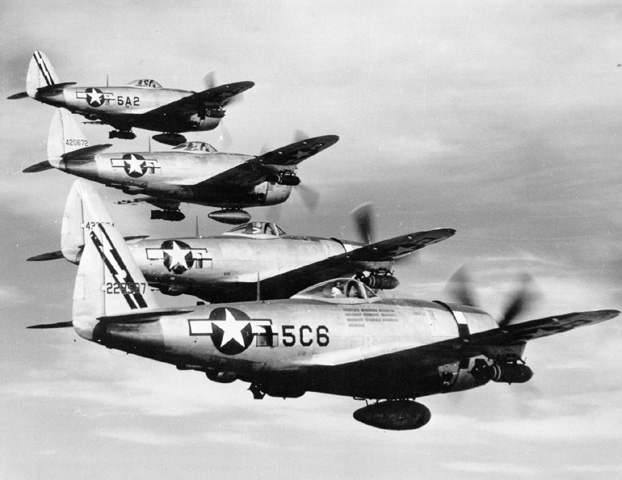 |
||
|
Built in greater quantities than any other US fighter, the P-47 was the heaviest single-engine WWII fighter to go into production and the first piston-powered fighter to exceed 500 mph. The Thunderbolt performed 546,000 combat sorties between March of 1943 and August 1945 and is considered the real forerunner of today's multirole fighters.
The Republic P-47 was the successor of a line of airplanes derived from the Seversky P-35, the XP-41, P-43 Lancer and XP-44 Rocket. The P-47 design team headed by Alexander Kartveli, Republic Aircraft Corporation's chief engineer, originally presented a design that was to be powered by a 1,150 hp Allison V-1710-39 engine with an armament of only two 0.50 caliber inch machine guns.1 A contract was awarded by the USAAC in November 1939, and for an even lighter XP-47A, but as intelligence was coming back from the war in Europe, it was becoming apparent that the performance goals of the XP-47 program were already inadequate. The USAAC issued new requirements which included:
• Airspeed of 400 mph at 25,000 feet. |
| The USAAC notified Kartveli that the XP-47A and the XP-44 Rocket contracts were canceled since the P-43/XP-44 airframe was too small to meet the new requirements. (The XP-44 Rocket was based on the P-43 Lancer airframe with a radial engine and never made it past the mock-up stage.) Kartveli then quickly prepared a rough sketch of a new XP-47B prototype, but it was a daring concept. He planned to use the new 2,000 hp Pratt & Whitney XR-2800-21, eighteen cylinder radial engine which was the largest and most powerful aircraft engine ever developed in the United States (up to that time).2 The new design would incorporate eight 0.50 caliber machine guns, additional ammunition, increased fuel capacity and armor protection for the pilot. (The final fuel load was slightly under the capacity required, but this was overlooked as the aircraft met performance specifications.) Additionally, the airplane would include an efficient super-charging duct system that would offer the least interrupted airflow. Kartveli therefore adopted the unorthodox method of designing this feature first and then building the fuselage around it. Despite the fact that the supercharger was in the tail and the engine was in the nose, the arrangement worked quite well—providing a system that was durable and less susceptible to battle damage. | ||
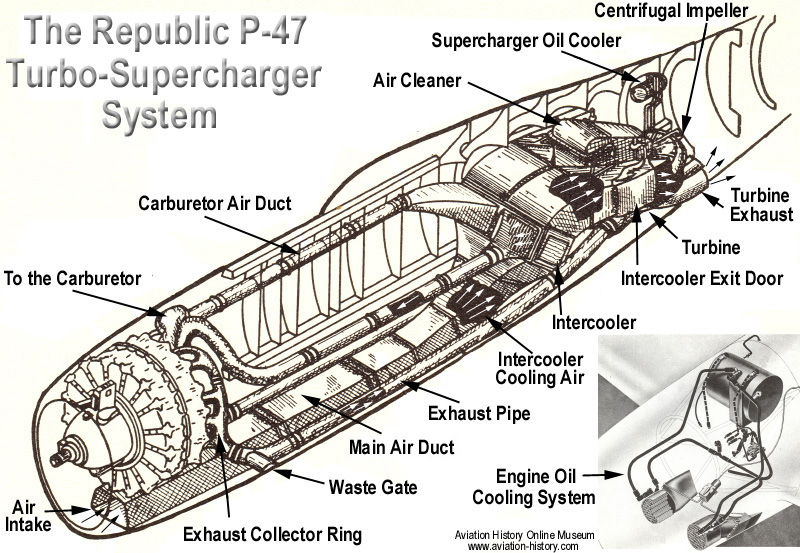
The large P-47 Thunderbolt turbo-supercharger was stowed internally in the rear fuselage, with a large air intake duct mounted under the engine, together with the engine oil coolers. Exhaust gases were piped back separately to the turbine and expelled through the turbine exhaust duct in the bottom of the fuselage. Ducted air is then fed to the centrifugal impeller and returned via an intercooler to the engine under pressure. The principle behind a supercharger is that the exhaust gas is directed to a turbine that has a shared axle with a centrifugal impeller. Outside air is directed through the compressor and delivered to the engine intake. This allows the engine to deliver more power as the airplane gains altitude in the thinner air of the upper atmosphere. | ||
|
All these features were costly in weight and the airplane would have a take-off weight of 11,600 lb. (5,262 kg) which was more than twice the weight of its contemporaries such as the
Supermarine Spitfire, the
Hawker Hurricane, the
Messerschmitt Bf 109, the
Curtiss P-40 and
Mitsubishi A6M Zero. Despite the monstrous size of the P-47, it would turn out to be one of the best three USAAF fighters of the war—the other two being the
North American P-51 Mustang and the
Lockheed P-38 Lightning.
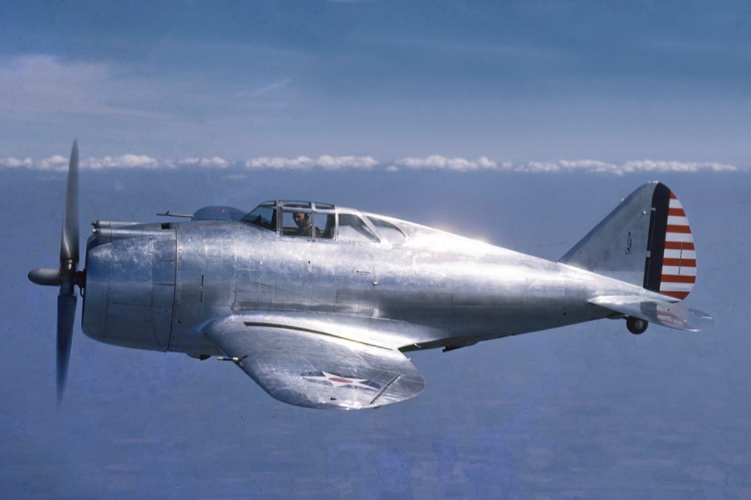 The XP-47B prototype. A contract was awarded on September 6, 19403 for the new XP-47B prototype and the maiden flight was only eight months later on May 6, 1941.4 The new plane dwarfed its pilots and all previous fighters, but it still proved to be an outstanding success. It was able to do everything Kartveli had hoped, and achieved a greater than expected speed of 412 mph (663 kph).5 Numerous problems were encountered during development, such as excessive control loads at high altitude and the canopy could not be opened at altitudes above 30,000 ft. Corrections included: balance panels to reduce rudder loads; blunt nose ailerons; a jettisonable sliding canopy to replace the hinged cockpit door; and all-metal flight controls to replace the fabric covered controls used on the prototype.6 (It was found during testing that the fabric flight controls would balloon out due to changes in atmospheric pressure.) The XP-47B crashed on August 8, 1942, but not before many problems had been solved.7 Despite the crash, an initial order was placed by the USAAC for 171 P-47Bs and 602 P-47Cs.8 One of the outstanding features of the P-47 was its remarkable acceleration when the aircraft was put into a dive. Any plane that attempted to break off contact by going into a dive would soon be overcome by the remarkable speed of the P-47. Once the P-47 caught up to its prey, one burst from its eight 0.50 machine guns would obliterate anything it got a bead on. |
||

|
To illustrate the rapidity of the increase in airspeed of the P-47 in a high speed dive, an event occurred during testing on November 13, 1942 by Lieutenant Harold Comstock and Roger Dyar of the 63rd Fighter Group who were performing a test level run at 30,000 feet at over 400 mph. After the first run, they put their P-47Cs into a dive to go to the next level for testing and during the dive, the airplane's speed increased very rapidly. Within seconds their airspeed indicated the equivalent of 725 mph.9 As velocity increased, they experienced extreme buffeting as they were approaching the realm of compressibility. Fortunately, they were able to recover, unlike others who experienced the same phenomena, and began dive recovery at too low an altitude to experience what is euphemistically called "uncontrolled flight into terrain."
At this altitude, this airspeed would put them beyond the speed of sound, but this would only be indicated airspeed since the terminal velocity of the P-47 is 600 mph,10 and the airspeed indicator was a straight pitot-static system with no air data computer for altitude and temperature correction. Also one would have to wonder how this airspeed was calculated since the early P-47 airspeed indicators only went up to 500 mph. To clarify this, the airspeed indicated was the equivalent of 725 mph, so the indicated airspeed would be calculated by engineering on the ground. Since this phenomena was not unique only to the P-47, later model airspeed indicators showed airspeeds up to 700 mph. The conventional three-bladed propeller could not efficiently utilize the power of the new engine, and a four-bladed propeller was adopted. Although this propeller was an admirable solution to the power gearing of the engine, the problem remained of providing sufficient ground clearance for its 12-foot (3.66 m) diameter. If a conventional undercarriage were to be employed, its suspension would have been too far outboard to permit the wing installation of the guns and ammunition requested by the USAAF. Therefore, Kartveli had to design a telescopic landing gear which was nine inches shorter retracted, than when extended. Numerous other problems were to be faced in absorbing the loads and stresses which would be imposed when a battery of eight 0.50 caliber guns, (a phenomenal heavy armament for that time) were fired simultaneously, and in providing the necessary tankage for the quantities of fuel stipulated to make the machine the first true single-engined strategic fighter. |
|
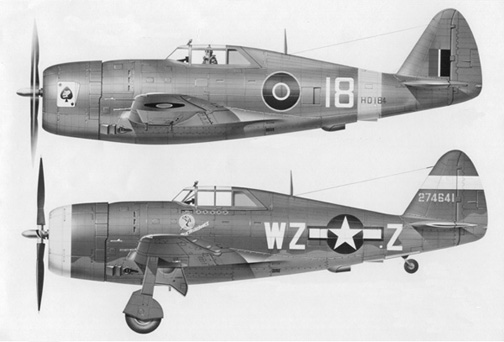
The P-47D-15-RE Thunderbolt on top, was the first version to have underwing pylons to use droppable fuel tanks. Below is a P-47D-1 with white bands on the nose and tail to distinguish it from the Focke-Wulf Fw 190A. The P-47B entered USAAF service in November 1942, becoming officially operational with the Eighth Air Force stationed in the UK on April 8, 1943. However, the P-47B's range was not adequate for escort duties and its maneuverability at low and medium altitude was poor. Since it was almost twice as heavy as its opponents, it exhibited a poor rate of climb, but had other advantages that more than compensated where it was lacking. In spite of its early shortcomings, the P-47 at least showed promise as a measure of real protection for Allied bombers which had previously suffered very heavy losses. In January 1943, when the USAAF's 56th Fighter Group arrived in the United Kingdom with its massive Republic P-47 Thunderbolts, RAF Spitfire fighter pilots banteringly suggested that their American colleagues would be able to take evasive action, when attacked by undoing their harnesses and dodging about the fuselages of their huge mounts. Although the Thunderbolt was certainly big, making it the largest and heaviest WWII single engined single-seat fighter ever built, its sheer size was not to prove detrimental to the Thunderbolt's subsequent operational career. The first tasks of the Thunderbolt were high-altitude escort duties and fighter sweeps in which the new aircraft acquitted itself well, despite the inexperience of its pilots. It was soon discovered that the heavy Thunderbolt could out-dive any Luftwaffe fighter, or for that matter, any Allied fighter. This provided a decisive method of breaking off combat when necessary, but at low and medium altitudes it could not match the rate of climb or maneuverability of German fighters. It's one main shortcoming was that of insufficient range to permit deep penetration into Germany, but means were already being sought to add to the P-47B's 305 US gallons of internal fuel. At the time of the Thunderbolt's European debut, radial-engined single-seat fighters were a rarity, the only other such fighter operational in Europe being the Focke-Wulf Fw 190A. To prevent confusion between the two fighters of the opposing sides, the engine cowlings of the Thunderbolts were painted white and white bands were painted around the vertical and horizontal tail surfaces—an appropriate comment on recognition standards appertaining at that time, as it would seem impossible to mistake the sleek and beautifully-contoured German fighter for the portly Thunderbolt. However, mistakes in aircraft recognition were common while making split-second decisions in the frantic pace of combat.
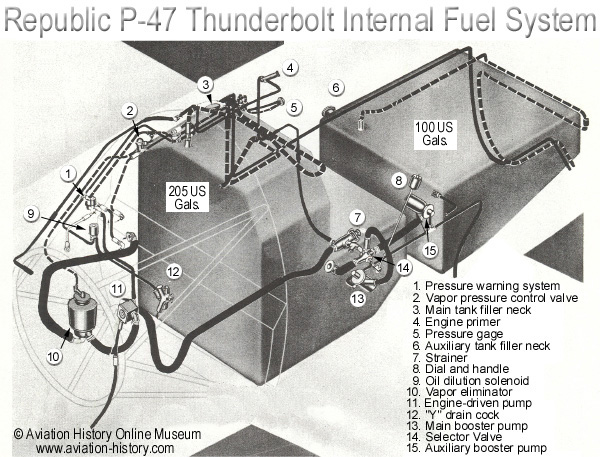
By mid-1943, improved P-47Cs were becoming available with external fuel tanks to increase range and a longer fuselage to improve maneuverability. The P-47D was the major production version of which 12,602 were produced. Early P-47Ds looked very much similar to the P-47C, but there were 21 variants of this model. 354 P-47Gs were built by Curtiss in Buffalo and 130 P-47Ms were built with a 2,500 hp engine giving a maximum speed of 473 mph (761 km/h). The P-47M version was used for anti V1 Flying Bomb duties. The final model, the P-47N, had extended wings and an additional 100 US gallons of fuel. It was developed too late to see much action in Europe and was primarily used in the Pacific theater. The fastest model was the XP-47J, which did not go into production. On August 4, 1944, this plane reached a level speed of 504 mph. Production plans were shelved in favor of another P-47 development, the Republic XP-72. P-47s flew more than 546,000 combat sorties between March 1943 and August 1945, destroying 11,874 enemy aircraft, some 9,000 locomotives and about 6,000 armored vehicles and tanks. Only 0.7 per cent of the fighters of this type dispatched against the enemy were lost in combat. As a testament to the survivability of the P-47, it should be noted that the top ten aces who flew the P-47 returned home safely. Before the war was over, a total of 15,579 Thunderbolts were built, about two-thirds of which reached operational squadrons overseas.
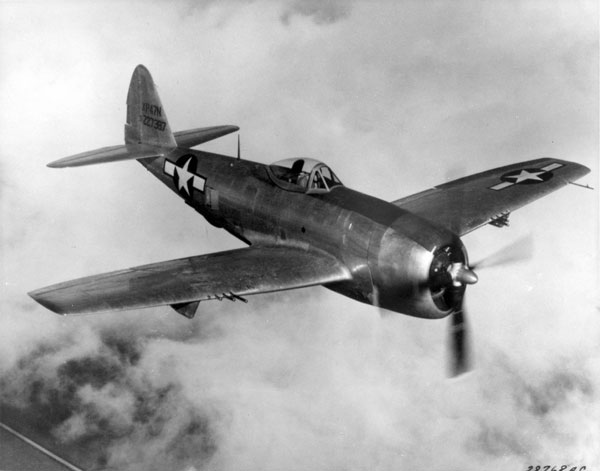
The final version, the P-47N, was built primarily for use against the Japanese in the Pacific theater. Shown is a XP-47N fitted with a bubble canopy.
One Pilot's Initial Reaction To The P-47 IntroductionOne day in January 1943, General Hunter, the Commander of the 8th Fighter Command, came to visit us at Debden. He said he had a surprise for us. We were soon to re-equip with the very latest American fighter, the P-47 Thunderbolt. As he spoke we heard an unusual engine noise outside and one of the new fighters landed and taxied up beside one of our Spitfires. We went outside to look it over. It was huge—the wing tip of the P-47 came higher than the cockpit of the Spitfire. When we strapped into a Spitfire we felt snug and part of the aircraft—the Thunderbolt cockpit, on the other hand, was so large that we felt if we slipped off the goddamned seat we would break a leg! We were horrified at the thought of going to war in such a machine: we had enough trouble with the Focke-Wulf 190's in our nimble Spitfire Vs—now this lumbering seven-ton monster seemed infinitely worse, a true air inferiority fighter. Initial mock dog-fights between Thunderbolts and Spitfires seemed to confirm these feelings—we lost four Thunderbolt pilots in rapid succession, spinning in from low level, while trying to match Spitfires in turns. In the end our headquarters issued an order banning mock dog fighting in Thunderbolts below 8,000 feet. Gradually, we learned how to fight in the Thunderbolt. At high altitude, she was a hot ship and very fast in the dive; the technique was not to mix it with the enemy, but to pounce on him from above, make one quick pass and get back up to altitude; if anyone tried to escape from a Thunderbolt by diving, we had him cold. Even more important, at last we had a fighter with the range to penetrate deeply into enemy territory—where the action was. So, reluctantly, we had to give up our beautiful little Spitfires and convert to the new juggernauts. The war was moving on and we had to move with it. The change to the Thunderbolt might have been necessary militarily, but my heart remained with the Spitfire. Even now, thirty years after I flew them on operations, the mere sound or sight of a Spitfire brings me a deep feeling of nostalgia and many pleasant memories. She was such a gentle little airplane, without a trace of viciousness. She was a dream to handle in the air. I feel genuinely sorry for the modern fighter pilot who has never had the chance to get his hands on a Spitfire—he will never know what real flying was like. | ||
| Specifications: | ||||
|---|---|---|---|---|
| P-47B | P-47C | P-47D | P-47N | |
| Dimensions: | ||||
| Wing span: | 40 ft. 9.75 in. (12.44 m.) | 40 ft. 9.75 in. (12.44 m.) | 40 ft. 9.75 in. (12.44 m.) | 42 ft. 7 in. (12.97 m.) |
| Length: | 35 ft. 3.25 in. (10.74 m.) | 36 ft. 1.75 in. (11.02 m.) | 36 ft. 1.75 in. (11.02 m.) | 36 ft. 1. in. (10.99 m.) |
| Height: | 12 ft. 8 in. (3.86 m.) | 14 ft. 1.75 in. (4.31 m.) | 14 ft. 7 in. (4.44 m.) | 14 ft. 8 in. (4.47 m.) |
| Wing Area: | 300 sq. ft. (27.87 sq. m.) | 300 sq. ft. (27.87 sq. m.) | 300 sq. ft. (27.87 sq. m.) | 322 sq. ft. (29.91 sq. m.) |
| Weights: | ||||
| Empty: | 9,346 lb. (4,239 kg.) | 9,900 lb. (4,491 kg.) | 10,000 lb. (4,536 kg.) | 11,000 lb. (4,990 kg.) |
| Gross: | 12,245 lb. (5,554 kg.) | 12,500 lb. (5,670 kg.) | 14,500 lb. (6,577 kg.) | 16,300 lb. (7,394 kg.) |
| Max. T/O: | 13,360 lb. (6,060 kg.) | 14,925 lb. (6,770 kg.) | 19,400 lb. (8,800 kg.) | 20,700 lb. (9,390 kg.) |
| Performance and Equipment: | ||||
| Max. Speed: | 429 mph (690 km/h) @ 27,800 ft. 8,473 m. |
433 mph (697 km/h) @ 30,000 ft. 9,144 m. |
428 mph (689 km/h) @ 30,000 ft. 9,144 m. |
467 mph (752 km/h) @ 32,500 ft. 9,906 m. |
| Service Ceiling: | 42,000 ft. (12,810 m.) | 42,000 ft. (12,810 m.) | 42,000 ft. (12,810 m.) | 43,000 ft. (13,106 m.) |
| Range: | 550 miles (885 km.) | 640 miles (1,030 km.) | 475 miles (764 km.) | 800 miles (1,287 km.) |
| Max. Range: | 1,100 miles (1,770 km.) | 1,250 miles (2,012 km.) | 1,700 miles (2,736 km.) | 2,200 miles (3,541 km.) |
| Powerplant: |
Pratt & Whitney 2,000 hp, turbo-supercharged R-2800-21. |
Pratt & Whitney 2,000 hp, turbo-supercharged R-2800-21. |
Pratt & Whitney 2,000 hp, turbo-supercharged R-2800-63. |
Pratt & Whitney 2,800 hp, water injected turbo-supercharged R-2800-57/ -73/-77. |
| Armament: | Eight, wing mounted 0.50 in. machine guns. |
Eight, wing mounted 0.50 in. machine guns. One 500 lb bomb. |
Six or eight, wing mounted 0.50 in. machine guns. 2,500 lb bombs or ten 5 in. rockets. |
Eight, wing mounted 0.50 in. machine guns. 3,000 lb (1,360 kg) bombs or ten 5 in. rockets. |
| Endnotes: |
|---|
|
1. David Mondey. The Concise Guide to American Aircraft of World War II. New York: Smithmark Publishers, 1996. 216. 2. Enzo Angelucci and Peter Bowers. The American Fighter. Sparkford, Nr. Yeovil Somerset, 1987. 390. 3. David Mondey. 216. 4. Enzo Angelluci and Peter Bowers. 390. 5. William Green. Famous Fighters of the Second World War. New York: Doubleday and Company, Inc., 1967. 84. 6. Ibid. 85. 7. David Mondey. 217. 8. Lloyd S. Jones. US Fighters. Fallbrook, CA: Aero Publishers., 1975. 115. 9. Howard Mingos, ed. The Aircraft Year Book for 1943. New York: Aeronautical Chamber of Commerce, 1943. 273. 10. Roger A. Freeman. Thunderbolt. A documentary History of the P-47. Osceola, Wisconsin: Motorbooks International, 1992. 25. |
© Larry Dwyer. The Aviation History Online Museum.
All rights reserved.
Created September 20, 1997. Updated February 4, 2021.